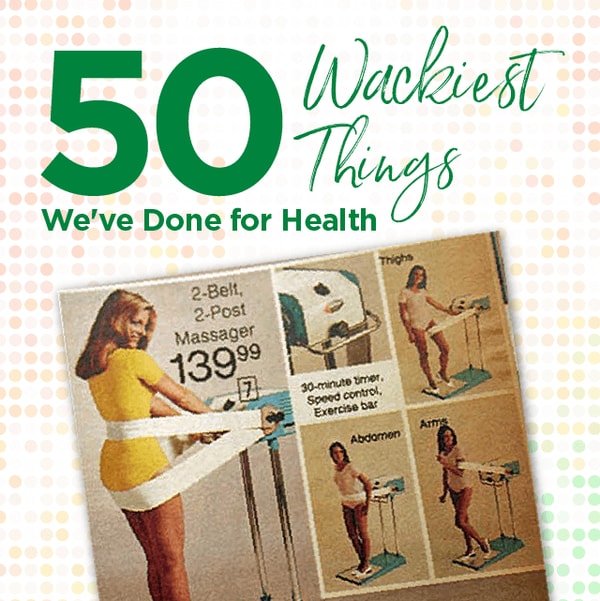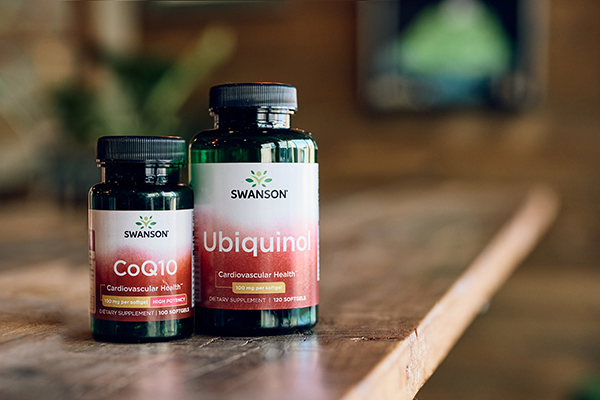What won’t some of us try in the name of health? That might be an easier question to answer than what we will try. And that thought is underscored by some of the crazy (and sometimes crazy-fun) things people have tried over the last five decades in an effort to get healthy and fit.
Why five decades? Because this month marks Swanson Health’s 50th birthday! From our humble beginnings in 1969 with a vitamin E supplement until now, with over 22,000 health and wellness products available, we’ve seen many fitness trends come and go. Some of them, like Swanson®, have remained trusted and reliable, and one thing remains tried and true—nutrition will always be at the core of good health.
That’s why we continue to innovate purer, simpler, more effective ways to nourish bodies and minds.

Fun Facts in Lifestyle, Wellness & Nutrition from 1969
The year Swanson was founded, the average cost of gas was 35 cents a gallon and the average house would set you back around $15,550.00.1 Here are some more fun facts from 1969:
- The price of a daily newspaper in 1969 was 10 cents2
- A 10.7 oz can of Campbell’s Soup was 10 cents2
- Americans ate more: beef, potatoes, refined cane sugar, eggs, milk, full-fat ice cream and margarine than today. Now we eat more chicken, cooking oils, corn sweetener, corn products, cheese, rice and yogurt.3
- Julia Child influenced a rise in French cuisine and complex dishes
- Backyard BBQs and picnics were popular in 1969 with favorite dishes like Swedish meatballs, buffalo wings, iceberg wedge salad, and party burgers (hamburgers, cheeseburgers, etc.)
- New Food & Restaurant options included Frosted Mini-Wheats (breakfast cereal, Kellogg), Pringles (potato snacks, Proctor & Gamble), Wendy's (chain restaurant), Long John Silver's Fish 'n Chips (chain restaurant)
- 1969 White House Conference on Food, Nutrition, and Health recommended that the FDA consider developing a system for identifying the nutritional qualities of food. This eventually led to the first voluntary nutrition labelling by food companies.4
Wacky Wellness Popular in the 1960s
#1 Vibrating Belts
What if you could just strap on a vibrating belt and jiggle away thigh, belly and derriere fat? Vibrating exercisers have been a thing since as early as the 1900s, but they made a comeback during the 50s and 60s.5 Think this is a thing of the past by now? Think again! You can still get something similar today—Vibro-Belt infomercials air late night.
#2 Roller Massage Tumbler
Want a nice, relaxing massage at home? Roller massagers hoped to give us exactly that. With textured wooden rods suspended on a rotating drum, these massagers were one of our earlier, albeit clunky, self-care efforts. The device promised to help relax and trim your muscles, specifically your arms, stomach and back. Some modern foot massage rollers take a similar approach today, and the concept seems to be more practical for home use on a smaller scale.
#3 Metrecal Protein Powder
Metrecal protein powder offered 225 calories per serving to be taken 4 times per day as a "Satisfying Food for Weight Control.” But, do the math—it’s only 900 calories a day! That isn’t exactly the healthiest approach to managing weight. Metrecal also made wafers, and 9 of the wafers were equivalent to one Metrecal protein drink.6
#4 Carnation Slender
On a similar note, in 1964 Carnation introduced Instant Breakfast, a powdered drink mix marketed as a quick breakfast. It’s still available today as Carnation Breakfast Essentials. But soon after its initial release, Carnation realized people were using it as a meal replacement option for weight loss and decided to market it to dieters as Slender.
#5 The Buttermilk Diet
How would you feel about consuming only buttermilk all day long? This wacky diet involved drinking 6 glasses of buttermilk each day and nothing else, which would only amount to about 911 calories each day.7 It was one of many unhealthy dieting fads of its time.
#6 Jazzercise
Jazzercise is one of the most memorable dance fitness crazes of the 60s, and it’s still going strong today. Jazzercise was founded by Judi Sheppard Missett, a professional dancer who held dance classes in Chicago but quickly realized students were attending for the exercise, not to become a dancer. She started offering fun workout classes with a jazz warmup that was eventually dubbed “Jazzercise,” and maintained trend-status well into the 80s.
#7 The Drinking Man’s Diet
Nothing about this was a good idea, but somehow the $1 pamphlet detailing this diet managed to become a best seller in its time. The “diet” focused on eating meat instead of carbs and drinking plenty of gin, vodka and wine. It should come as no surprise that the founder of Harvard’s School of Public Health deemed it extremely unhealthy.8
#8 Slim-Mint Gum
Promising to help you eat less and weigh less, the makers of “medicated” Slim-Mint gum claimed to work to control appetite between meals and stop over eating.9 The gum contained benzocaine, a numbing ingredient.
#9 Martinis and Whipped Cream Diet
Despite its name, this diet did not ONLY include martinis and whipped cream, it just had a flashy name thrown in for good measure. The author claimed right on the cover that you could eat “fried foods, appetizers, gravies, sauces, dressings, caviar and ice cream.” The book included a list of how many calories it took to burn many foods.
Wacky Fitness Fads of the 1970s
#10 Sleeping Beauty Diet
The premise of the Sleeping Beauty Diet may sound innocent enough at first glance—if you are asleep, you probably (hopefully!) aren’t eating at the same time. But the fad took an extremely dangerous turn as people started using sedatives to help them sleep longer. Supposedly even Elvis tried it and vowed to never do it again—smart decision.
#11 The Cookie Diet
In 1975 Dr. Siegal introduced The Cookie Diet, a calorie-restricted diet focused on eating specially formulated, meal-replacement cookies 6 times per day, plus a few additional “hunger-controlling” foods containing protein. At first the diet was only available to his weight-loss patients, but he eventually started marketing his weight loss cookies to the public.
#12 Dexatrim
In response to an increasing demand for diet pills as a way to get slim quick, Dexatrim diet pills came on the market in the 1970s. But it is not the same Dexatrim formula available in stores today. The first iteration contained not-so-heart-healthy phenylpropanolamine (PPA), which was eventually banned from over-the-counter products by the U.S. Food and Drug Administration (FDA).10
#13 Air Shorts or Air Jeans
Once inflated, these wild-looking shorts put pressure on your waist, hips and thighs, supposedly massaging and soothing muscles as you move. The manufacturer encouraged people to wear them while doing daily tasks or while exercising.
#14 Sauna Suit
This sauna suit of the 70s claimed to seal in body heat to melt away the pounds. Sauna suits became popular again in recent years and while they can make you sweat, sweat does not equal fat. You’re basically dehydrating your body.11
#15 Twist ’N Tone
This exercise device promised us a way to get into shape without expensive gym equipment. You would basically stand on a rotating plate and use body weight to keep yourself balanced while twisting back and forth. It was actually kind of fun to use! You can get sturdier, more robust versions of this device today.
#16 The Grapefruit Diet
Originally started in the 30s, the grapefruit diet gained popularity again in both the 70s and 80s. The diet consists of, you guessed it, eating a lot of grapefruit. That isn’t the only thing you could eat, but the diet was extremely low carb and low calorie, with grapefruit at every meal. Some of the more restrictive versions of the diet kept calories below 1000 a day. Not healthy!
Wacky Wellness Trends of the 1980s
#17 Jane Fonda Teaches Us “No Pain, No Gain”
The aerobics craze reached new heights in the 80s with Jane Fonda leading the pack. Jane had us all donning leotards and doing wacky workouts in our living rooms across the nation. Her popular “no pain, no gain” mantra sticks around today.
#18 Cabbage Soup Diet
How would you feel about eating nothing but cabbage soup for 10 days? This extremely low-calorie diet wasn’t exclusive to the 1980s but it was popular then nonetheless. Dieters may have lost weight with the cabbage soup diet but would have gained it back quickly after resuming normal eating.
#19 Oprah Goes on the Optifast Liquid Diet
In 1988, Oprah famously dropped 67 pounds in just over 4 months with Optifast, increasing its popularity. This high-protein, calorie-controlled liquid diet was (and still is) only available while under the supervision of a physician or registered dietitian due to its extremely restrictive nature.
#20 The Scarsdale Diet
Perhaps the first low-carb, high-protein diet to gain popularity, The Scarsdale Diet was developed in the late 70s but reached fad status in the 80s. Unlike many protein-centric diets today, it allowed merely 1,000 or fewer calories per day!
#21 Lean Cuisine
Frozen dinners made healthy? Lean Cuisine was created as a healthier, frozen-meal alternative to Stouffer's meals as the popularity of the microwave increased in the early 80s. By 1983, the meals were so popular that the company was having trouble keeping up with demand.
#22 The Beverly Hills Diet
The Beverly Hills Diet came on the scene in 1981, focusing primarily on eating fruit plus a few very specific combinations of foods. The instructions on how and when to eat everything were just as strict. For example, fruit was always to be eaten alone with an hour between each type of fruit and two hours between types of foods.
#23 Buns of Steel
The original Buns of Steel workout launched in 1987, giving us a new perspective on toning our derriere. The VHS class was led by a former World Class pole vaulter aiming to take us all a path toward a tighter, firmer behind.
Fitness Fads Popular in the 1990s
#24 Dr. Atkins' New Diet Revolution
With his signature, high-protein, low-carb diet plan, Dr. Atkins, a New York cardiologist, took the weight loss industry by storm. This popular low-carbohydrate diet is probably the most recognizable dieting fad of the century.
#25 Hula Hooping is Reborn
Hula hoops certainly weren’t new in the 90s, but a hula hoop rebirth was triggered when a Colorado-based band began tossing hula hoops into their audiences at concerts. Hoop dancing soon became popular for concertgoers and a fun way to get in a workout.12
#26 Thighmaster
Thighmaster became a household name following a 1991 infomercial featuring Suzanne Somers. After the commercial aired, the company sold 6 million of the devices in just over a year.13
#27 Gliding and Sliding Exercises
Low-impact cardio gained popularity in the 90s too—from the Powerslide, a slideboard and booties combo that gave us a rollerskating-type workout at home, to Tony Little’s Gazelle, an in-home elliptical type device. We were on a mission to glide our way to wellness.
#28 Richard Simmons
Who could forget the colorful outfits and enthusiastic personality of Richard Simmons? His Sweatin’ to the Oldies series ran from the late 80s through early 90s featuring chart-topping hits and heart-rate boosting moves.
#29 Billy Blanks
In the late 90s, many of us were kicking and punching our way fit alongside a leotard-clad Billy Blanks. You simply can’t mention 90s fitness without mentioning this Tae Bo workout series.
#30 The AB ROLLER®
The AB ROLLER® was invented in 1994, giving us an alternative to crunches. The device went on to become one of the most popular exercise products in history, generating a billion dollars in sales worldwide.14 You can still get a similar device called the Ab Trainer Club Pro from the same company that started it all.
#31 Teeter Inversion Table
Hanging around upside down for health? In 1997, the Teeter Inversion Table made its first appearance on the Home Shopping Network, bringing inversion therapy into homes across the country.15 The devices are marketed primarily for helping with back health, including muscle tension. Updated versions still available today.
Wellness Trends of the 2000s
#32 South Beach Diet
This fad diet of the early 2000s focused on eating high-fiber, low-glycemic carbohydrates, lean protein and unsaturated fats. The South Beach Diet was created by a cardiologist as a “foolproof plan for fast and healthy weight loss.” It has several phases with varying restrictions. Phase 1 prohibits almost all carbohydrates, but later phases are more inclusive and aimed at establishing long-term habits.16
#33 The Master Cleanser
The Master Cleanser, sometimes called Master Cleanse, is a juice fast during which you consume nothing other than a lemonade drink made either hot or cold with lemon juice, water, cayenne pepper and grade B maple syrup, plus a nightly laxative tea and a morning “salt water flush.” This extreme cleansing diet has been around since the 70s, but it gained media attention in 2006 when it was rumored that Beyoncé used the Master Cleanser to prepare for a film role.
#34 Electric Ab Stimulators
Electric muscle stimulation (EMS) devices have been in the works for decades, some of the earliest versions were even banned by the FDA. In the 2000s Slendertone’s first Flex belt was introduced in the US after launching in Europe in 1999. These devices claim to tone your muscles by making them contract through the use of electricity.
#35 Planking Trend
Remember planking? Until around 2009 the plank pose was synonymous with Pilates, but then the internet exploded with photos of people “planking” in some very unusual and sometimes dangerous places. It became a pop culture phenomenon gaining celebrity recognition before finally fading away. Thankfully the real plank pose, done safely on the floor instead of somewhere dangerous, is still around, and it’s a great core workout.
#36 Fitness Bootcamps
In the 2000s, we upped the intensity of our workouts as boot camp-style fitness became a trending way to torch calories. Bootcamps popped up at gyms across the country—from targeted bootcamps for specific muscle groups to general fitness.
#37 CrossFit
This is also when CrossFit was launched, giving us one of the most diverse, high-intensity fitness methods out there combining aerobics with calisthenics and incorporating workout equipment from many exercise disciplines.
#38 Zumba®
Zumba officially started in the 90s, but most of us didn’t learn about it until the 2000s when Zumba classes became widely available. Zumba was created by a Columbian dancer and features wildly challenging dance moves that give you a killer workout.
#39 Whole Grains
Who knew whole grains would become trendy? It happened in the late 2000s, when more than 2,800 new whole grain products came on the market in 2008 alone as diets shifted to less processed foods.17 That’s a trend worth keeping around, and one that we see continuing today even among supplements. Check out our line of Real Food Vitamins for nutrition derived from whole food sources.
#40 The Christian Bale Diet (Tuna Apple Diet)
To prepare for his 2004 role in The Machinist, Christian Bale is said to have eaten a diet of only one can of tuna and/or one apple per day for four months while being supervised by a physician. Not long after word spread, people started trying the dangerous diet for themselves. Apples and tuna are both healthy foods but not if that’s the only thing you’re eating! Extremely restrictive diets like this are not a good idea.
#41 P90X
P90X launched in 2003 and promised to get us in the best shape of our lives in merely 90 days. Advertisements for this extreme, high-intensity workout seemed to find their way onto every channel in those days.
Wacky Wellness of the 2010s
#42 The Pineapple Diet
The 2010s brought us raw diets and highly-restrictive mono diets (single ingredient diets) like The Pineapple Diet, promising extreme weight loss in a short period of time. These diets are definitely not the best idea. We need a variety of nutrients to stay healthy, and any weight lost from diets like these is likely to return quickly.
#43 Shake Weight
A dumbbell modified to oscillate when shaken—the Shake Weight flew off shelves in 2010 with a reported 2 million units sold.18 But not all experts were convinced that it was as good of a workout as standard workouts targeting the same muscle groups as the Shake Weight.19
#44 The Military Diet
This diet actually has nothing to do with the military despite the name and rumors, but that didn’t stop it from becoming a fad in the early 2010s. The diet could supposedly cause an unhealthy drop of 10 lbs in a week, with a strict daily eating plan that included some highly-restrictive and nutrient limiting days.
#45 Toning Shoes & Clothes
What if your clothes could help you get in shape? It sounded too good to be true, but rocker bottom shoes and toning clothing from brands like Reebok, Sketchers and MBT claimed to help us build muscle and burn more fat. Sadly, research didn’t back those claims, showing no statistical differences in muscle exertion or caloric burn when they were worn.20
#46 Waist Trainers
Waist trainers saw a surge in popularity in 2015 after Kim and Khloe Kardashian posted photos of themselves wearing waist trainers on Instagram. Kim included a caption saying that she was “obsessed with waist training.”21 After that, waist trainers were selling out. But experts say they only provide a temporary slimming effect and can permanently damage organs and nerves.22 Yikes!
#47 Prancercise®
This one may just top the wacky list for the current decade. Prancercise® by Joanna Rohrback became a YouTube sensation in 2012. This freewheeling combo of springy dancing while walking went absolutely viral. The founder says her method is also about self-expression, non-violence and conservation.23 If you have ever noticed someone prancing enthusiastically through the park, you might have witnessed Prancercise® in action.
#48 Aerial Yoga
Why do your yoga on the ground when you can do it in the air? Aerial yoga or anti-gravity yoga combines traditional yoga poses with Pilates and dance while using a special type of silk hammock. Seasoned aerial yoga enthusiasts look graceful doing it. The rest of us? Not so sure!
#49 Mermaid Swim Classes
All our fairytale dreams came true with the invention of mermaid-themed swim classes. Adults and children alike started donning colorful swim tails and enjoying mesmerizing aquatic workouts. And why not? It looks so fun!
#50 Animal Yoga
Whether you're game for yoga on horseback, practicing your downward dog next to an actual dog, or enjoying the company of goats, bunnies, or feline friends while you tune in to body and mind—animal yoga is on the rise. Some fans are in it to raise funds for shelters, others are just there for the heartwarming experience. Either way, this wacky new yoga trend is just one more way to inspire more movement and a healthier you.
+ One to grow on! Cycle Karaoke
What’s better than spin class? Singing, dancing and spinning all the same time, of course! At least that’s the thought driving the current trend of cycle karaoke classes. Maybe you have so much fun singing and dancing that you forget you’re working out!
The Future of Wellness
With the best of intentions, people have sought all kinds of wild ways to get into shape over the last five decades. Who knows what wackiness the future will hold? But whatever that may be, Swanson plans to keep on being your wellness journey partner with our science-backed, innovative health and wellness products, plus expert tips and advice, for many years to come.
And speaking of wellness innovations, check out our new line of Pure Science Herbals featuring clinically-studied ingredients sourced from nature for supporting energy, heart, brain and joint health.
Reminisce with us! Share some wacky fitness fads you remember from over the years in the comments below. Don't forget to Sign up for Swanson Health emails to be the first to know about new articles and special promotions.

About Lindsey Toth, MS, RD
Registered Dietitian, Swanson Health
Lindsey is a nationally recognized registered dietitian and nutritionist with a soft spot for ice cream. She empowers people to take charge of their health by finding the balance between the pleasure and nourishment in food.
Her philosophy is that you should take care of your body because it’s the only permanent home you have. It’s what inspired her to pursue a career in nutrition and, ultimately, led her to Swanson Health.
Sources
1 What Happened in 1969 Important News and Events, Key Technology and Popular Culture. The People History. http://www.thepeoplehistory.com/1969.html (Accessed 06/29/2018)
2 1969 Trivia, Facts & History. Pop Culture Trivia. https://pop-culture.us/Annual/1969.html (Accessed 06/29/2018)
3 What’s on your table? How America’s diet has changed over the decades. Pew Research Center. http://www.pewresearch.org/fact-tank/2016/12/13/whats-on-your-table-how-americas-diet-has-changed-over-the-decades/ (Accessed 06/29/2018)
4 Front-of-Package Nutrition Rating Systems and Symbols: Phase I Report. National Center for Biotechnology Information. https://www.ncbi.nlm.nih.gov/books/NBK209859/ (Accessed 06/26/2018)
5 Belt Vibrator. Kansas Historical Society. https://www.kshs.org/kansapedia/belt-vibrator/15638 (Accessed 06/26/2018)
6 8 bygone diet foods we thankfully never have to eat again. MeTV. https://www.metv.com/lists/8-bygone-diet-foods-we-thankfully-never-have-to-eat-again (Accessed 06/26/2018)
7 Milk, buttermilk, fluid, whole. USDA. https://ndb.nal.usda.gov/ndb/foods/show/01230 (Accessed 06/26/2018)
8 The Drinking Man’s Diet. Forbes. https://www.forbes.com/2004/04/21/cz_af_0421feat.html#154d55865928 (Accessed 06/26/2018)
9 Here’s What Dieting Looked Like in the 1960s. MeTV. https://metv.com/stories/heres-what-dieting-looked-like-in-the-1960s (Accessed 06/26/2018)
10 Phenylpropanolamine (PPA) Information Page. U.S. Food & Drug Administration. https://www.fda.gov/Drugs/DrugSafety/InformationbyDrugClass/ucm150738.htm (Accessed 06/26/2018)
11 The Most Dangerous Health Trends We Saw in 2016. MSN Lifestyle. https://www.msn.com/en-ph/health/wellness/the-most-dangerous-health-trends-we-saw-in-2016/ss-BBxqRRU#image=9 (Accessed 06/26/2018)
12 In Hula Hoop Rebirth, A Fad Comes Full Circle. The Washington Post. http://www.washingtonpost.com/wp-dyn/content/article/2008/07/18/AR2008071802838_3.html (Accessed 06/26/2018)
13 O.C. inventor squeezed ThighMaster into American culture. The Orange County Register. https://www.ocregister.com/2013/12/05/oc-inventor-squeezed-thighmaster-into-american-culture/ (Accessed 06/26/2018)
14 History. The Abs Company. https://theabscompany.com/history/ (Accessed 06/26/2018)
15 Teeter History. Teeter. https://teeter.com/blog/teeter-history/ (Accessed 06/26/2018)
16 South Beach Diet. Mayo Clinic. https://www.mayoclinic.org/healthy-lifestyle/weight-loss/in-depth/south-beach-diet/art-20048491 (Accessed 06/26/2018)
17 The Decade in Food: Trends from 2000 to 2010. Delish. https://www.delish.com/food/a1148/food-trends-decade/ (Accessed 06/26/2018)
18 The Shake Weight Hits $40 Million In Sales. CNBC. https://www.cnbc.com/id/38788941 (Accessed 06/26/2018)
19 Shake Weight Review. Consumer Reports. https://www.consumersearch.com/as-seen-on-tv/shake-weight (Accessed 06/26/2018)
20 Will Toning Shoes Really Give You a Better Body? American Council on Exercise. https://www.acefitness.org/getfit/studies/toningshoes072010.pdf (Accessed 06/26/2018)
21 What is Waist Training. Health. http://www.health.com/pregnancy/what-is-waist-training (Accessed 06/26/2018)
22 Waist trainers strangle organs, doctors warn. USA Today. https://www.usatoday.com/story/news/nation-now/2015/11/05/waist-whittlers-dangers/75225022/ (Accessed 06/26/2018)
23 Prancercise® A Fitness Revolution. http://www.prancercise.com/ (Accessed 06/26/2018)
*These statements have not been evaluated by the Food and Drug Administration. These products are not intended to diagnose, treat, cure or prevent any disease.





